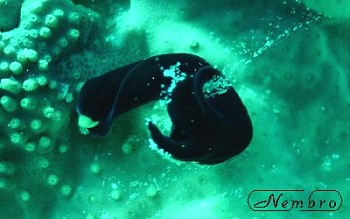Re: Chelidonura flavolobata from Red Sea
April 21, 2002
From: Marina Poddubetskaia

Dear Bill,
Thank you for these confirmations of Chelidonura. I just forgot to tell you about something else on C. flavolobata during this stay in the Red Sea.
One day I was photographing a C. flavolobata and suddenly I made a lot of movement and the animal came off. But, surprisingly it stayed near the rocks attached to corals by a white substance seen on the joined photo. It reminded me of a spider's web - when spiders fall down they always make a line to stay attached. Is it just a coincidence or can C. flavolobata make a substance to attach itself to rocks ?
Best wishes
Marina.
marina.poddubetskaia@francetelecom.com
Poddubetskaia, Marina. , 2002 (Apr 21) Re: Chelidonura flavolobata from Red Sea. [Message in] Sea Slug Forum. Australian Museum, Sydney. Available from http://www.seaslugforum.net/find/6763Dear Marina,
Have a look at the page on How slugs crawl. Most snails and slugs have glands which produce a mucous layer on which the foot glides along by muscular waves. In some cephalaspideans, like Chelidonura and other aglajids, the body, including the foot is covered by a heavy layer of cilia, and there is no muscular sole to the foot. In these animals a set of glands at the front of the body produce a layer of mucus which the cilia pushes around the body so the animal actually crawls along in a tube of mucus. This is useful when they crawl through sand and soft sediments, and also, as you have observed, when they fall loose on hard substrates. They also can sometimes be seen 'abseiling' down from one ledge to another by using this mucus tube - so comparing them to spiders is an excellent comparison.
It is intersting to see that in your photo the animal is crawling across a coral colony. Popular books often have photos of Chelidonura crawling over corals, and often the caption says they are feeding on coral mucus. This is quite wrong. We now know that they feed on small flatworms which often occur in large numbers on coral and soft coral colonies.
Best wishes,
Bill Rudman
Related messages
-
Eggs of Chelidonura flavolabata
From: Lior Harari, March 29, 2007 -
Chelidonura flavolobata from the Red Sea
From: Kamal El Tawil, May 17, 2006 -
Chelidonura flavolobata - extreme close up
From: Oren Lederman, March 9, 2006 -
Re: Chelidonura flavolobata - color variation
From: Oren Lederman, March 19, 2005 -
Black Chelidonura flavolobata with white lobes
From: Oren Lederman, March 19, 2005 -
Chelidonura flavolobata - color variation
From: Oren Lederman, March 17, 2005 -
Chelidonura flavolobata from the Red Sea
From: Oren Lederman, March 9, 2005 -
Chelidonura flavolobata from Egyptian Red Sea
From: Michael Mrutzek, January 4, 2005 -
Chelidonura flavolobata from the Red Sea
From: Harro H. Quitzau, July 2, 2003 -
Chelidonura flavolobata from Red Sea [2]
From: Nils Anthes, May 31, 2003 -
Chelidonura flavolobata & C. inornata
From: Bill Rudman, May 31, 2003 -
Chelidonura flavolobata from Red Sea [3]
From: Nils Anthes, May 31, 2003 -
Chelidonura flavolobata from Red Sea [1]
From: Nils Anthes, May 28, 2003 -
Chelidonura flavolobata from Egypt
From: Marina Poddubetskaia, March 12, 2003 -
Chelidonura flavolobata from Red Sea
From: Marina Poddubetskaia , April 16, 2002 -
Chelidonura flavolobata from Saudi Arabia
From: Gordon T. Smith, January 30, 2001 -
Chelidonura flavolobata from Red Sea
From: Erwin Koehler, January 22, 2001
